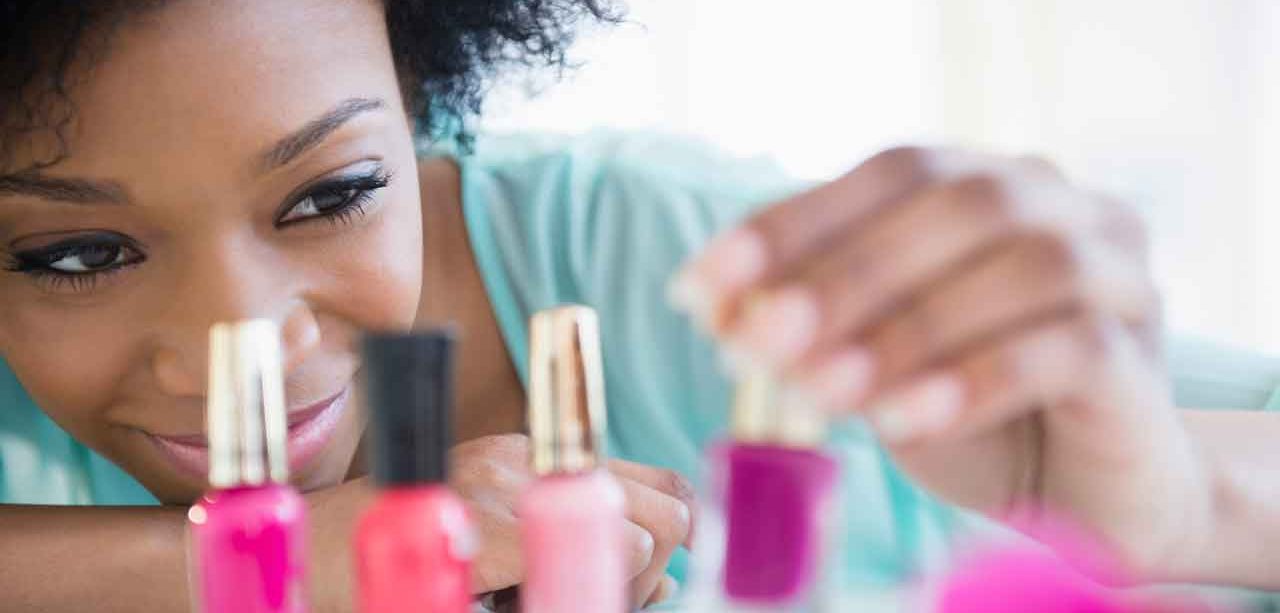What Is Nail Polish Made of? Is Nail Polish Toxic?

Many nail products contain toxic chemicals, including known carcinogens. Learn about what nail polish is made of and the safest nail polish brands.
A manicure may seem harmless, but scrutiny of the cosmetic industry has raised questions about the safety of what nail polish is made of.
An investigation by The New York Times called attention to the dangers that repeated exposure to potentially toxic chemicals could pose for nail salon workers. The hazards, the study found, include respiratory trouble, skin disorders, increased risk of miscarriage, and even cancer.
The investigation coincided with increased public concern about the safety of chemicals in nail polishes, glues, removers, and acrylic nails for everyone who uses them, including salon customers and people who do their nails at home.
YOU MIGHT ALSO LIKE: Why Your Nails Could Signal Health Problems
What is nail polish made of? Is nail polish toxic?
Warnings about the safety of nail polish focus on potentially toxic ingredients to avoid, known as the “big five” — dibutyl phthalate, formaldehyde, formaldehyde resin, toluene, and camphor.
Dibutyl phthalate, or DBP, minimizes chipping in nail polish. Phthalates may disrupt your endocrine system and interfere with normal hormone functioning. Few human studies have been done on DBP specifically, but animal studies have linked exposure to liver damage and decreased fertility.
The Occupational Safety and Health Administration (OSHA) warns that DBP can cause skin, eye, nose, and throat irritation, as well as nausea and vomiting. In Australia, it is classified as a risk to the human reproductive system, and the European Union (EU) has banned its use in personal care products.
Formaldehyde strengthens polish and prolongs shelf life, protecting against bacteria growth. Miniscule amounts of formaldehyde, such as the amount your body naturally produces or that is found in some vaccines, are non-toxic. At higher levels, however, formaldehyde is classified as a carcinogen.
Frequent exposure can cause dizziness, skin disorders, allergic reactions, nausea, and respiratory problems.
Formaldehyde resin is a by-product of formaldehyde. It has been the focus of fewer tests than other nail polish chemicals, but studies indicate it may cause allergic reactions and be linked to organ toxicity.
Toluene creates a smooth application and finish in nail polish. It is also used in many nail polish removers and has a sweet, strong smell, the result of its highly toxic fumes. Fumes have been linked to headaches, nausea, dizziness, fatigue, and insomnia.
Prolonged exposure can cause damage to the nervous system, cardiac arrhythmia, and harm to unborn children. Toluene, like DBP, is banned from use in cosmetics in the EU.
Camphor, which gives nail polishes a glossy finish, is used in small amounts in cold treatments and nasal sprays. Some studies have called the use of camphor in personal care products into question, as repeated exposure has been linked to allergic reactions and skin irritations. At high doses, camphor toxicity can cause vomiting, respiratory distress, and even seizures.
Several cosmetic brands now produce nail polishes classified as “five-free,” meaning they do not contain any of the big five chemicals. Polishes classified as “three-free” do not have DBP, formaldehyde, or toluene.
Other potential hazards
The big five are not the only chemicals of concern in nail products. Other studies have identified two other serious hazards.
Methacrylate compounds are found in many nail polish primers, glues, and artificial nails, as well as plastics. Inhaling particles can cause difficulty breathing as well as irritating your eyes, nose, throat, and skin. Animal studies have shown that some methacrylate compounds are highly toxic and may cause cell mutations. They are on OSHA’s list of hazardous chemicals found in nail salons.
Triphenyl phosphate, or TPHP, is added to some nail polishes to replace phthalates. Animal studies have shown that TPHP is also an endocrine disruptor and can affect the balance of sex hormones.
Research, published by Duke University and the Environmental Working Group, had women use polish that contained TPHP. The results showed that your body absorbs the chemical quickly. Within 10 to 14 hours of painting their nails, all participants had substantially elevated levels of metabolized TPHP in their urine.
The study also found that many nail polish brands that contain TPHP do not disclose it on their ingredient list. The Environmental Working Group publishes a database of polishes that contain TPHP.
The safest nail polish brands
To protect yourself from potentially hazardous chemicals in nail products, use brands that are three-free or five-free, as well as free from TPHP. Many nail polish manufacturers advertise products that do not contain even more chemicals as being 10-free and 15-free.
Choose nail salons that are well ventilated, for both your safety and that of the people who work there. Avoid acrylic nails and nail glues to prevent exposure to methacrylate compounds.
You can also limit manicures and pedicures to a very occasional treat to protect your health.
If you are pregnant, breastfeeding, or accompanied by a minor, it may be wise to avoid nail salons completely.
Updated:
July 13, 2023
Reviewed By:
Janet O’Dell, RN